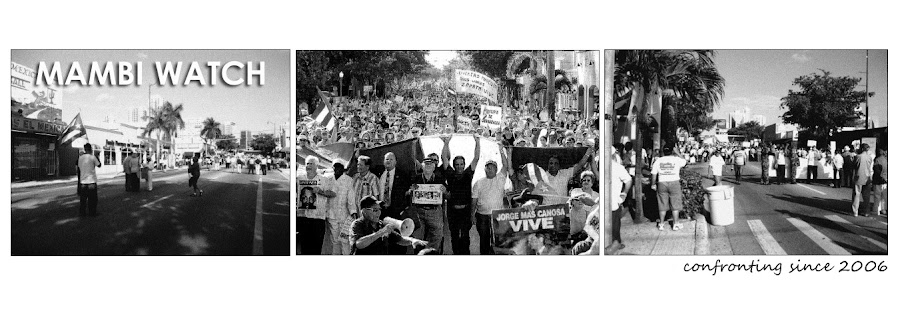Mr. Gomez mentions that his "job [in 'account planning'] is to know what consumers are thinking and feeling." It sounds like Mr. Gomez works in the field of applied psychology, but the evidence and explanations that Mr. Gomez proceeds to give is barren of any scientific evidence. Instead, Mr. Gomez gives us a collection of his general assumptions and simple conclusions.
He mentions that "there is general psychology and behavior common to most immigrants. For example a new immigrant will probably settle where he has family or friends living." This is accurate. Mr. Gomez is describing a general phenomenon known as ethnic solidarity. Perhaps unknown to Mr. Gomez, a study done two years ago examined ethnic solidarity in the Cuban-American community in an attempt to explain the "internal divisions" of this so-called monolith. The author (Heike C. Alberts) provides some insight into possible reasons why cohort waves are responding differently in polls. She states that since the 1980's the ethnic cohesiveness of the "Cuban enclave" in Miami has decreased due to a merging with the overall US economy, increased competition with other immigrant groups, and decreased preferential treatment within Cubans. Alberts believes that "deep rifts now exist among Cubans of different refugee generations, due to different class background, values, ideologies, religious beliefs, and race."(p.246)[*]
But, Mr. Gomez prefers to give his own interpretation based on his experiences alone, not scientific research. He most likely agrees that there are "internal divisions" within the Cuban-American community, but seems to be in denial over whether these divisions are authentic. Over time Mr. Gomez believes that "[t]here is a slow discovery process in which the [new Cuban immigrant] begins to, perhaps for the first time, reflect on the veracity (or lack thereof) of what the regime told them during their formative years... But eventually that exhaustion wears off and certain realities set in." Mr. Gomez then concludes that "[i]t’s far more likely that those younger Cubans [from the July 31 celebrations] will become more outspoken and intransigent than their forerunners." And, that newly arrived Cubans will also assume an "outspoken and intransigent" stance once they assimilate in Miami and watch the local Spanish channels, such as the increasingly popular America TeVe and Mega TV.
I have never heard of this "slow discovery process" theory, and neither does Mr. Gomez provide any evidence to support it.
Yet, Mr. Gomez is correct in stating that a "static model" for how people think is incompetent. But, I have never seen anyone (Ana Menendez or Joe Garcia) argue that the "static model" is appropriate. This is Mr. Gomez's false argument.
On the other hand, many have cited the FIU Cuba Poll to examine past and current attitudes of Cuban-Americans. Evidently, Mr. Gomez is arguing about a possible future which is likely, or not likely, to happen. Mr. Gomez offers no evidence to support his prediction, instead he only has faith that Cubans in Miami will become "more outspoken or intransigent." Only time will tell.
But, of course, Mr. Gomez would have a difficult time challenging the methodology and results of the FIU Cuba Poll or the Bendixen Poll. This may explain why he argues against interpretations and false arguments, not facts.
Guillermo Grenier, one of the principle authors of the FIU Cuba Poll, has written extensively on the factors explaining the growing political diversity within Cuban-Americans. In a 2004 study, Grenier attributed the growth of a stronger dissident movement in Cuba, unique immigration experiences of wave cohorts, political abandonment of the Cuba issue, and the natural passing away of a hard-line "exile ideology" as factors in political changes in Miami.
In 2006, Grenier added more factors to consider: the general political "relaxation" after the end of the Cold War, political diversity from new Cuban-American political groups, and Cubans living outside of South Florida (Cubans in New Jersey are more likely to favor a "national dialogue" with the Cuban government).
These are arguments that are supported by facts. Grenier never suggests a "static model." In fact, Mr. Gomez's "slow discovery process" theory may be accurate, but operating against its own inventor.
Comparing the 2000 FIU Cuba Poll with the 2007 Poll, one reaches a startling conclusion. On the question of a "national dialogue," Cubans who immigrated between 1974-1984 changed their minds in support from 40.2% in 2000, to 50.4 in 2007! That's some "slow discovery." And, about those young Cubans that Mr. Gomez mentions... they (US born Cubans) support a "national dialogue" more than ever! From 67.9% in 2000, to 82.5% in 2007! I guess living in Miami with that "historic exile" community does that to you.
There's plenty of more data to go over and interpret. But, the real question is: who's peddling a myth?
[*]Alberts, H. C. (2005). Changes in ethnic solidarity in Cuban Miami. The Geographical Review, 95, 231-248.
[Part 1]

No comments:
Post a Comment